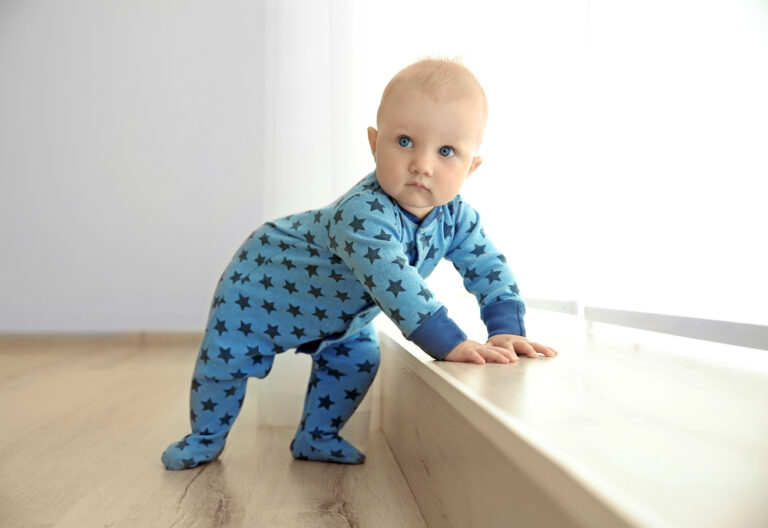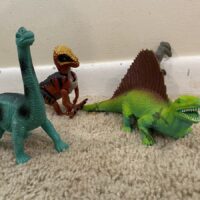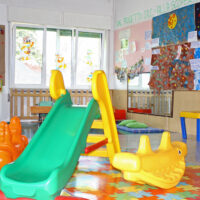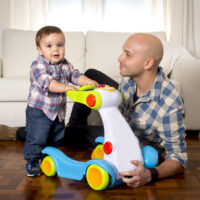Your baby starts learning how to use their leg muscles even as a newborn when they reflexively kick upwards when they are set feet-down on a flat surface. Even so, your baby probably won’t stand before they are 8 months old. Some babies don’t even stand up from the floor until they are 11-12 months. Below, we’ll take a look at how you can help your little one stand up from the floor on their own.
Start with Bouncing
Bouncing your baby is a great way to work your baby’s leg muscles and make them stronger. Most babies are ready to start bouncing as soon as they can support their head and neck on their own. You can bounce your baby up and down on your lap by holding them by their sides. You can also consider bouncers once your baby is ready.
Something that you should avoid is placing your baby in a walker. While baby walkers were once a staple in the average household, studies show that they are not safe. Additional safety measures (like making walkers wider than a doorway) were implemented in 2010, but since then the American Academy of Pediatrics has called to ban walkers altogether. In addition to being dangerous (especially when bumping into furniture or around stairs), walkers promote a sitting position instead of a standing position. This may impact the development of your baby’s hips and legs, possibly even causing them to become bow-legged. Baby push walkers are a good alternative.
RELATED: The Best Walking Toys
Be Enthusiastic
For the most part, walking is something your baby is going to develop naturally without too much help from you. What you can do is stay enthusiastic and offer encouragement as your baby meets new milestones. Get excited and clap for your baby when they pull themselves up, even if they stand for just a minute. You can even get excited when they fall down – this encourages them to keep trying and helps them to not be scared.
RELATED: How to Make Your Child Feel Loved and Valued
Give Your Baby Opportunities to Stand
If your baby is right at the age, their natural curiosity will have them pulling themselves up in no time. You can help by setting things just out of your baby’s reach and enticing them to grab them. This works best with a favorite toy, a book, or something your baby has an interest in. You can also just give your baby time to explore. Choose a room in the house that has been baby-proofed and let your baby crawl around, try to stand up, and just find out what they can do.
Toys that encourage sitting, kneeling, and standing are also a great idea. Kneeling is something that your baby is going to need to do to get themselves up. They usually do this because it offers a little more stability since they are still getting used to the movement that lets them stand. If you do buy stand-up activity centers, however, be sure that your baby can’t pull them down on top of themselves and stay nearby just in case. Heavier toys are usually less likely to tip over than lighter ones.
RELATED: The Best Baby Activity Tables
Let Your Baby Fall
Falling down is often scarier to the parents than it is to the child. I was fortunate to learn this early on from my mother-in-law, who would break into a round of applause and say, “Yay!” when my youngest fell on his bottom. She wasn’t scared so neither was he.
Even so, falling is part of the learning process. Your baby is going to learn to pull themselves up before they balance well on their feet. They are also going to fall back down, especially since they probably can’t sit gently down by bending their knees yet.
The best thing you can do is teach your baby to fall in a safe area. The first few times you practice, set him or her next to the sofa. Place a favorite toy or book near the edge of the cushion and watch as they try to pull themselves up. You can surround them with cushions the first few times, giving them something soft to land on. As your baby gets older, they’ll likely start putting their hands out to catch themselves when they fall.
Don’t Forget About Safety
Generally, you don’t need to worry about things like furniture anchors, baby gates, and similar baby proofing safety measures in the first couple of months home from the hospital. Until your baby is starting to crawl, there’s a low risk that they’re going to injure themselves. However, once your baby starts to move around on their own, either by crawling or pulling themselves up to stand, it’s important that you baby-proof your home.
Making sure furniture is steady and won’t topple over is key. In addition, clearing tables and low areas from items that may be unsafe for your little one is important.
FAQs – How to Teach Baby to Stand Up from the Floor
When should I teach my baby how to stand?
Learning to stand from the floor is one of many skills your baby learns as part of their motor development. This is something that your baby develops over time, getting better and better at using their muscles as they learn to do things like crawl, jump, and more.
You can start encouraging your baby to stand once they are supporting their own weight on their legs. Most babies start to pull themselves up from the floor around 6 1/2- 8 months, but you can start working with them as early as 4-5 months.
Even though it can be fun to help your baby walk, keep in mind that you will want to give them plenty of tummy time and time to crawl around, too. Tummy time and crawling are going to give your baby’s muscles the best workout when they are still young.
When will my baby stand without support?
Learning to stand without support has a lot to do with your baby’s muscle development. Your baby’s muscles in his or her stomach, back, hips, and legs need to be strong enough to support their weight. Additionally, your baby needs to have the balance to stand alone.
Balance is something that comes with practice, but muscle building is something you work on by exercising the muscles. Some babies stand on their own at just 8 months of age, but others take until they are 11-12 months old. Even if it takes a little longer, don’t worry. You shouldn’t feel concerned until your baby can’t stand on their own at 15 months old or if your child hasn’t met other developmental milestones.
Final Word
Teaching your baby to stand is the first step in reaching the walking milestone. Fortunately, there are lots of techniques for how to teach a baby to stand up from the floor that can help your baby get there. Most of them are as simple as interacting with your little one and encouraging them to work their muscles. Now, you can work with your little one so they can take that first step!






